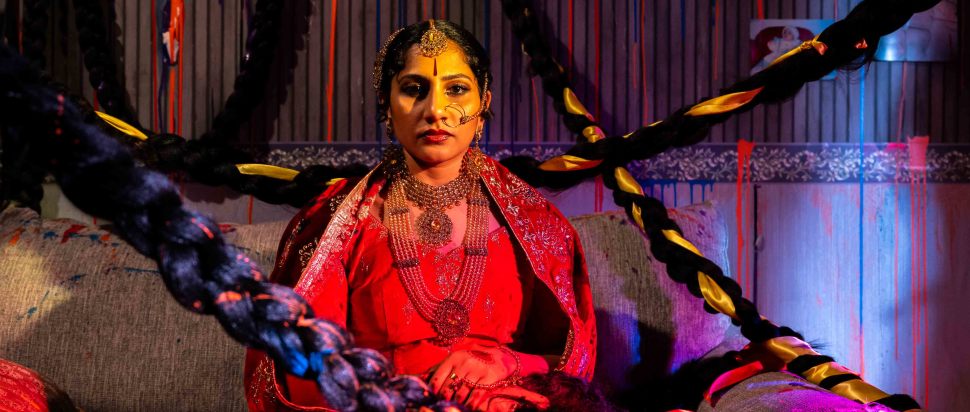Portrait of an Erased Estate: Aqsa Arif's Raindrops of Rani
At Edinburgh Printmakers, Aqsa Arif subverts the famous Sony Bravia 'Paint' advert that was filmed in her childhood council flat. Our Art Editor considers the necessity for creative expression in the face of growing threats to social housing
Aqsa Arif jogs my memory. It’s 2004, and in a flash between The Simpsons and Hollyoaks, a shot of grey, high-rise concrete buildings, scattered with litter and an abandoned shopping trolley pans. Out of thin air, the number four shaped out of concrete tetris emerges like some sort of miracle, an intervention penetrating the shameful, staged remnants of life. My mum, sitting next to me, shouts “That’s where I grew up!” I think that it’s pretty cool that my mum is represented on the tele in some shape or form and tell everyone and anyone who listens that Channel 4 thought my mum, and her upbringing, her accent, her ideas, were special.
Aqsa Arif jogs my memory and makes me think twice about that Channel 4 ident, filmed on the Aylesbury Estate, South London. Did Channel 4 class that as community outreach? Or was the intention to communicate that their broadcasts were out of reach to those who grew up on the Aylesbury estate? Too clever, too miraculous.
Unlike the ident suggests, my mum’s childhood was full of colour. For one, she was the proud owner of a tortoise called Humphrey, and while she was left to her own devices, she decided to brand him with his name in yellow paint. But his shell wasn’t quite big enough for all those letters, and after a failed attempt at hyphenation, she coloured him all in. My nan, despite her own impulses to paint everything she owned to give new coats of life, was appalled at the discovery of Humphrey's luminous makeover. Rest assured, Humphrey was cleaned up and relocated to a tortoise sanctuary. He’s probably still alive somewhere, munching lettuce, unaware of the stubborn bits of graffiti stuck in the crevices of his shell. If we were to read this story through the classist cultural imaginary, Humphrey is an exceptional tortoise because he 'escaped' the Aylesbury Estate – just as my mum did.
How much paint does it take to paint a tortoise’s shell? A sample pot would do, perhaps. How much paint does it take to flood a council estate in the colours of the rainbow? 70,000 litres. In 2006, two years after the first broadcast of that Channel 4 ident, Sony Bravia chose Prospecthill Circus in Toryglen, Glasgow, as its working-class canvas for a marketing feat. Constructed in the 1960s, the estate once comprised three tower blocks and maisonettes, though today it is nowhere to be found.
Before she was an artist but while her ideas were brewing, young Arif lived on the sixth floor of Queen’s Court, a 23-story high-rise at 24 Crossbank Road in Prospecthill Circus, with her mum and five siblings. As a child, Arif remembers living with an unrelenting feeling of unease and a cohesive obligation to express gratitude while her family waited in limbo for British citizenship after migrating from Pakistan. Emergency suitcases, packed by her mum, were always within reach. Mental maps of the estate were shaped and swapped, directing Arif where not to walk or when not to go out, her family’s safety cordoned off by racist violence and sectarianism. Solace was found in connecting with those who were also unable to work or chose their own home, and sometimes, in the community arts and crafts sessions that took place on the ground floor.
Asbestos lived within Prospecthill Circus; perhaps it was made to feel more welcome than the refugees and asylum seekers, who were targeted as scapegoats for the estate’s problems. Like so many council housing estates built in the rush to house baby boomers and to clear slum areas, it was determined that Prospecthill Circus was not worth repairing, instead fated to a short-sighted cycle of demonisation, demolition and regeneration – just as Margaret Thatcher dreamed. In the widespread and continued displacement and splintering of working-class communities, residents have little to no say in where to next.
As an alternative to Queen’s Court, Arif’s family – which, remember, comprises seven people – were offered a one-bedroom flat in Glasgow’s Red Road Flats just nine years prior to that very estate’s own demolition. Pushing through the threat of deportation, it was Arif’s mum who stood up to the council and demanded more room for her children to grow. Consequently, they were relocated to a neighbouring flat in Toryglen. But the demolition of the Red Road flats in 2015 served as warning: no one can expect to be settled for too long.
In between the stages of demonisation and demolition of Prospecthill Circus, residents vacated, and Sony waltzed in to film a 70-second advert. With a budget of two million, and a crew of 250 directed by Jonathan Glazer, Sony detonated paint in all directions across the estate to the backing of The Thieving Magpie by Gioachino Rossini. While there’s no narrative, a clown with a painted grin storms on screen for precisely one second – perhaps he’s the one who pulled the trigger. After filming, the clean-up job took five days and sixty people, and something I can’t quite stomach is that a playpark was assembled purely for the visuals, then disassembled as soon as they called it 'a wrap'. The year following the advert’s premiere, Arif watched her block implode from a friend’s 20th floor flat. Spectacle after spectacle.
Now, Arif is a full-time artist – the first in her family, though not the last. She makes art in the 'right' kind of hi-rise – business-like and sleek – organised by Edinburgh Printmakers Spaces, a charitable cause that means rent is never due. Inside, her studio is an explosion of colour in preparation for her exhibition. Giant braids of jet-black hair intertwined with ribbon guard Arif’s portfolio from that of the other studio holders. The hair is where her rebuttal begins.

A Pittering, A Pattering of Paint (2025) by Aqsa Arif, courtesy of the artist
Raindrops of Rani – the film that gives Arif’s exhibition its name – opens with a mother, Heera, oiling her daughter Sohni’s hair in a Glasgow council flat. Heera’s character has been borrowed from Heer Ranjha, a tragic romance passed down through Punjabi folklore that shares narrative similarities to Romeo and Juliet, Arif explains. What was once a tragic conclusion is reframed as a narrative threshold, creating space for the character’s emergence in a different context that, while seemingly distant, is historically entangled through colonialism.
In this retelling, Heera and Sohni have been displaced from Pakistan to the council estate due to floods caused by British colonial control of infrastructure, which continues to worsen from climate change. A familiar coming-of-age arc can then be traced: a daughter pulls away from her mother to discover her own identity, only to later realise the love and pain in how she was raised. Throughout, the mother-daughter relationship is touchingly personal yet chimerical, with dialogue borrowed from Arif’s childhood: “Be careful on the way home, and don’t take the shortcut,” Heera tells Sohni, as Arif’s mum once advised her.
The one-second shot of a clown in the Sony advert becomes an astute narrative departure point in Raindrops of Rani. Arif renders visible the otherwise invisible mechanism of state bureaucracy through a circus of clowns who roam the estate, seemingly thriving off the power to deport and displace. For Heera, the threat of multiple displacement looms large; her agoraphobia and coulrophobia – fear of clowns – consequently grow out of control, along with her Rapunzel hair. Meanwhile, Sohni – whose name is a homophonic jab at Sony – transforms into a clown as she comes of age, a kind of assimilation that satirises the structural pressure to conform or play a role that suppresses diasporic expression. Ultimately, through compromise and sacrifice, Sohni saves Heera, who in turn saves Sohni from drowning in paint by severing her hair.
I replay a sequence of Raindrops of Rani: a clown who haunts the estate serves Heera an eviction notice in a rainbow envelope, forcing the taped letterbox open with a grin. In drippy PR spin, it reads: “Your home is about to make history – One final, breathtaking spectacle of colour, like no other!” Arif’s home made history, and it no longer exists. In part, the set for Raindrops of Rani was built within a green screen studio because Arif’s home, which made history, no longer exists. But the green screen technique further allowed the artist to draw on the heightened visual language of Bollywood, evoking dreamlike flashbacks that recall Heera’s life prior to displacement. In doing so, Arif has created her own breathtaking spectacle like no other.
Raindrops of Rani ruptures an aching void in the public record left behind by former residents of Prospecthill Circus, whose voices have been overshadowed by a marketing miracle. Where there are gaps in the artist's fraying childhood memories, she turns to fantasy, the surreal and nostalgia, curbing the questions for her family to avoid reopening old wounds. In her own hunt for stories, Arif makes art to express a closeness with her mum, who, in turn, sews for her daughter’s films, such as the long braids of Heera’s hair.
Aqsa Arif jogs my memory and reminds me that the Aylesbury Estate is pending demolition, and I haven’t asked my mum enough questions about her upbringing and her ideas.
Aqsa Arif: Raindrops of Rani, Edinburgh Printmakers, Wed-Sun until 2 Nov, 10am-6pm; part of Edinburgh Art Festival
